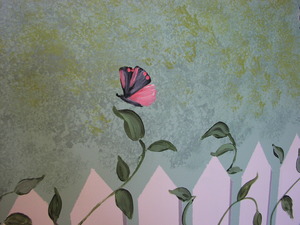If you love the look of aged plaster walls like you might see in a quaint French café or an old Tuscan farmhouse, you will be pleased to know how easy it is to achieve this look in your home. This aged, antique look can simply be done by layering a few different colors of paint. Adding an artistic, designer flair to your walls is relatively easy with what’s known as faux painting. There is no need to hire a professional contractor. Most faux painting techniques can be done by any do-it-yourself decorator. (Yes, this means you!)
Color washing is one of the faux painting techniques you can use to give your walls a soft, aged appearance. With this technique, a base coat of paint is covered by a coat of lighter colored paint mixed with a glaze. The glaze softens the base coat color which shows through.
Latex paint is usually preferred for color washing over oil based paint because it dries quicker and is easier to clean up. Use a flat, satin or eggshell type paint for the base coat. Apply the base coat like you would normally and allow it to dry completely.
Next you will mix four parts glaze to one part paint. There are several different ways to apply the glaze and each one will give you a slightly different effect.
Sponges, Cloth- Applying the glaze mixture with a sponge will give you more of a textured look. Use a circular motion, as if you were washing the wall, with both a sponge or bunched up cloth.
Brushes- Use short, criss-cross strokes and then take a dry brush to “feather” the brush lines by lightly sweeping over them.
Sponge paint your walls.
Sponging is another simple technique that you can use to paint on walls, furniture and other décor. Natural sea sponges will give you the best results.
With the sponging technique, you simply add layers of color to your wall using a hand-held sponge. Begin by pouring a small amount of latex paint into a tray. Dip the sponge into the paint and wipe off any excess before applying to your surface. Use consistent pressure to dab paint onto the wall, being careful to avoid making patterns. Once your first color is completely dry, you can repeat this technique again with another color. The more colors you use, the more interesting your effect becomes.
It’s a good idea to practice sponge painting on a piece of plywood or cardboard before trying this technique on your walls.
Use faux painting techniques on furniture and other décor.
Color washing and sponge painting are two of the most commonly used faux painting techniques for walls. There are many other faux techniques that can be used for walls, furniture, ceramics and other household décor, such as:
- Splattering
- Distressing
- Woodgraining
- Verdigris
- Tortioseshelling
- Stenciling
You can learn more about faux painting techniques with this DVD faux painting kit, which includes patented tools designed specifically for the faux painting techniques you will learn how to do. Once you learn these techniques, you can create beautiful, custom décor for yourself or perhaps even go into business selling your own custom creations!




